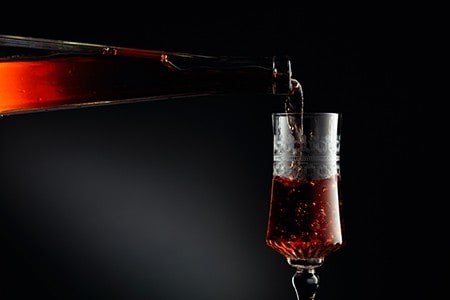Fortified Vs Unfortified Wine: What is the Difference? [Simple Explanation]

The world of wine quickly becomes confusing to the newcomer due to various technicalities and rules.
Our aim here at wineturtle.com is to make things more accessible and easier to understand.
So, in today's guide we explain the differences between fortified and unfortified wine.
An obvious guess would be that one is made stronger than the other.
And you're on the right track, but it's important to know how and why.
A logical first step is to start with the basics, so let’s see what unfortified wine actually is.
What is Unfortified Wine?
As you know, wine is produced from grapes through the process of fermentation. I’m not going to explain the whole process here, but the result is unfortified wine.
This is wine as most of us know it.
A beverage with an average alcohol content of between 11 and 16% (although it can get a lot higher and lower).
Unfortified wine refers to all wines produced through the standard winemaking process (either traditional or industrialized) achieved with nothing but fermented grape juice.
This means your preferred red wine, white wine, rosé wine or sparkling wine is an unfortified wine.

What is Fortified Wine?
Before explaining what fortified wine really is, let's just get something straight.
According to Montana State tax legislature, the term fortified wine refers to any wine with an alcoholic concentration higher than 16% and no more than 24%.
This leads us to believe any wine that is within this range is fortified, but this is simply wrong.
An unfortified wine can have a higher alcohol concentration than this too.
This is typically the case with sweet dessert wines. Achieved through the addition of sugar and yeast to the dry wine. The final wines produced are not only sweeter, but they are also more alcoholic.
So, what's the real explanation?
Fortified wine in the true meaning of the word means a wine produced through the addition of a spirit to the original unfortified wine base.
The spirit is typically brandy or cognac made from the same type of wine you want to fortify. The method was discovered in the 17th century by the wine merchants transporting wine from continental Europe to England.
The wine was transported by ships and the less than ideal conditions often spoiled the wine cargo.
Merchants, therefore, had to come up with a solution to preserve wine, and noticed that adding more alcohol preserved its properties for longer.
Some of the most popular fortified wines include Port, Madeira, Sherry, Vermouth, and Marsala, although there are also other less popular types, such as Vin Santo from Tuscany.
Fortified Vs Unfortified Wine
They're two very different types of wine. Let's take a look at the key differences in the comparison table below.
Unfortified Wine
Fortified Wine
Dry / Semi-dry / Sweet
Typically sweet
Typically 11-16% alcohol content
Typically 16-24% alcohol content
Aged in wood or metal casks
Aged in wood casks exclusively
Best served chilled or at room temperature
Best served at room temperature
Appetizer / Meal / Dessert wines
Mostly dessert wines
Final Thoughts
You now know the difference between fortified and unfortified wines, but things are not as simple as they seem.
There are many unfortified wines that have a higher concentration of alcohol due to the high content of sugar in the grape juice prior to fermentation.
Moreover, contrary to popular belief, fortified wines don’t usually have a strong spirit-like aftertaste.
The brandy added to the wine loses its characteristics and only enhances the flavors of the original beverage.
You won’t feel the brandy but will likely taste the flavorful caramel, nutty, or toffee hints in the wine.
But then, these hints are common to many unfortified wines. So, when it comes down to choosing your favorite between the two styles, it can be very difficult.
The best thing to do is to learn which wines go with which foods and pair them with the right dishes to make sure you value the true aromas and flavors in the wine.
